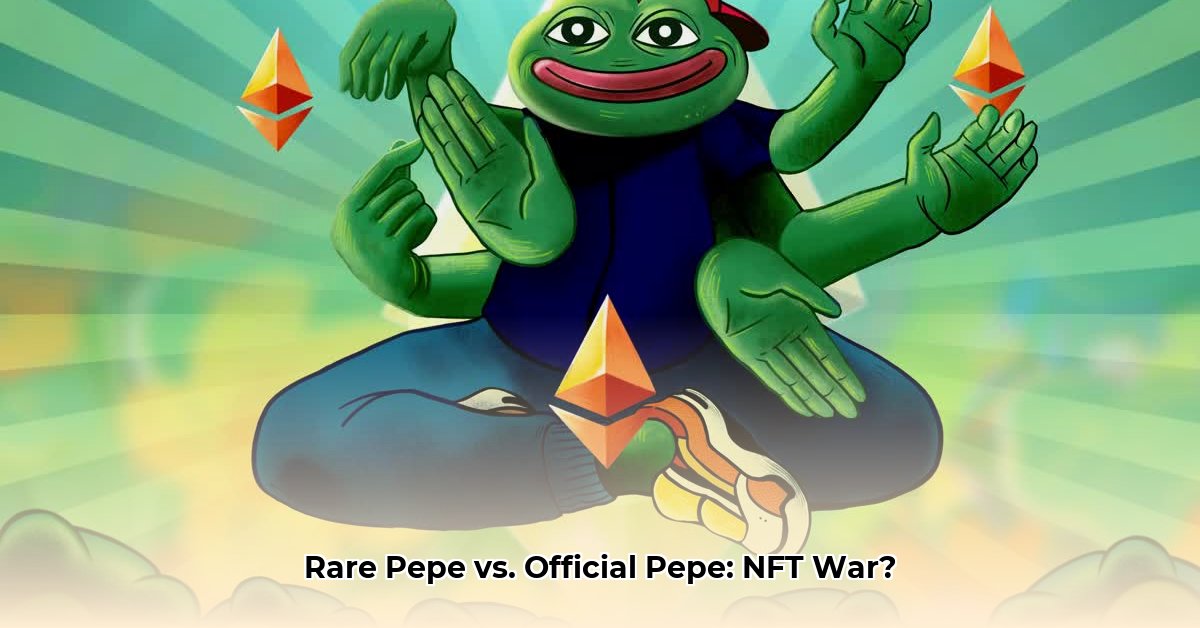
So, you're intrigued by the world of Pepe NFTs? This comparative analysis dives into two prominent collections—Rare Pepes and Art Official Pepe—examining their histories, technologies, artistic styles, market performance, and investment potential. We'll also explore the regulatory landscape and offer insights for informed decision-making. Whether you're a seasoned NFT investor or a curious newcomer, this guide provides a comprehensive overview to navigate the Pepe NFT ecosystem.
Rare Pepes: The Genesis Collection
Rare Pepes represent a foundational moment in NFT history. Launched on the Counterparty platform (a protocol built on the Bitcoin blockchain), these digital trading cards predate the Ethereum-dominated NFT landscape. This early adoption grants them significant historical significance. Think of them as the original, limited-edition collectibles of the NFT world. Only 1774 cards exist, each with a unique design and verifiable provenance recorded on the blockchain. The artistic style reflects the raw, often crude aesthetic of early internet memes, a stark contrast to the polished graphics often seen in later NFT projects. A particularly noteworthy example is the "Nakamoto" Pepe card, which enjoys legendary status among collectors. But this extreme scarcity comes at a cost. Trading volume is significantly lower compared to Ethereum-based collections, resulting in limited liquidity. "The high value of Rare Pepes is directly tied to their historical significance and scarcity," says Dr. Anya Sharma, Professor of Digital Economics at the University of California, Berkeley. This makes buying and selling a challenging process, potentially impacting short-term gains. Will this historical importance translate into long-term value, though? That remains to be seen.
Art Official Pepe: The AI-Powered Evolution
Art Official Pepe adopts a markedly different approach. Residing on the Ethereum blockchain, this collection boasts greater accessibility and liquidity compared to its predecessor. Comprising 4269 unique Pepe portraits, the collection utilizes artificial intelligence (AI) for image generation leading to a consistent, polished aesthetic. This AI-driven approach, however, introduces a key differentiating factor and raises questions surrounding the concept of artistic authenticity and copyright concerns. The project incorporates measures intended to guarantee originality, but the debate surrounding the artistic merit of AI-generated art continues. While the Ethereum platform provides broader access and smoother trading, the lack of artistic diversity among the works might prove less appealing to collectors seeking unique, individual pieces. "The use of AI in generating Art Official Pepe NFTs presents both opportunities and challenges," comments David Chen, Senior Analyst at CoinMetrics. "The efficiency of AI generation allows for a larger supply, increasing accessibility, but inherent questions about the artistic value and uniqueness compared to handcrafted art remain." Therefore, a crucial factor for investors is whether a consistent aesthetic is preferable over artistic variance.
Rare Pepes vs. Art Official Pepe: A Detailed Comparison
The following table summarizes the key distinctions between Rare Pepes and Art Official Pepe:
| Feature | Rare Pepes | Art Official Pepe |
|---|---|---|
| Blockchain | Counterparty (Bitcoin) | Ethereum |
| Art Style | Diverse, early internet meme aesthetic | Consistent, AI-generated portraits |
| Total Supply | 1774 | 4269 |
| Rarity | Extremely rare | Moderately rare |
| Market Performance | High prices, low volume | Lower prices, high volume |
| Accessibility | Very low | High |
| Investment Potential | High risk, potentially high reward | Moderate risk, moderate reward |
Investment Analysis: Navigating the Risks and Rewards
Investing in NFTs carries inherent risks. Market volatility and regulatory uncertainty are ever-present factors. Let's analyze the short-term and long-term investment prospects of each collection:
Rare Pepes: Short-term gains are possible through shrewd buying and selling of less actively traded cards. Long-term value hinges on the enduring appeal of the project's historical significance and the sustained interest of collectors. The limited supply is a key factor.
Art Official Pepe: Short-term profitability might be achieved through rapid market response and capitalizing on hype cycles. Long-term success depends on community engagement, establishing a brand identity, and the ongoing market acceptance of AI-generated NFTs.
Disclaimer: This analysis is for informational purposes only and does not constitute financial advice. Always conduct thorough research and only invest what you can afford to lose.
Regulatory Landscape: Navigating the Uncharted Waters
The legal landscape surrounding NFTs remains dynamic. Intellectual property rights, particularly concerning AI-generated art, are still evolving. Tax implications vary significantly by jurisdiction. Furthermore, the risk of market manipulation is ever-present, requiring vigilance and careful due diligence. Staying apprised of regulatory developments is crucial for informed investment decisions and risk mitigation.
Conclusion: Choosing Your Pepe
Both Rare Pepes and Art Official Pepe present compelling, albeit distinct, investment opportunities. Rare Pepes cater to collectors seeking historical significance and extreme rarity. Art Official Pepe offers broader accessibility and a potentially more active market. The optimal choice hinges on your investment goals, risk tolerance, and preference for artistic style. It is critical to conduct in-depth research and carefully evaluate your own risk tolerance before committing any capital. Remember, the Pepe NFT landscape, like the broader cryptocurrency market, is characterized by its inherent volatility.